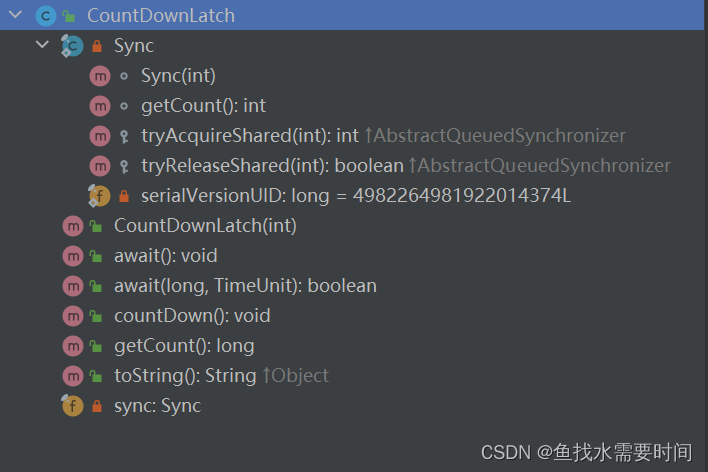JUC 常用 4 大并发工具类 CountDownLatch、CyclicBarrier、Semaphore、ExChanger
JUC 常用 4 大并发工具类 CountDownLatch、CyclicBarrier、Semaphore、ExChanger

文章目录
- [什么是JUC?](/developer)
- [4大常用并发工具类](/developer)
- [CountDownLatch](/developer)
- [CyclicBarrier](/developer)
- [Semaphore](/developer)
- [Exchanger](/developer)
什么是JUC?
JUC就是java.util.concurrent包,这个包俗称JUC,里面都是解决并发问题的一些定义类,该包的位置位于java下面的rt.jar包下面。
4大常用并发工具类
- CountDownLatch
- CyclicBarrier
- Semaphore
- ExChanger
CountDownLatch
CountDownLatch,俗称 闭锁 ,作用是类似加强版的Join,是让一组线程等待其他的线程完成工作以后才执行。
就比如在启动框架服务的时候,我们主线程需要在环境线程初始化完成之后才能启动,这时候我们就可以实现使用CountDownLatch来完成。
构造方法:
/**
* Constructs a {@code CountDownLatch} initialized with the given count.
*
* @param count the number of times {@link #countDown} must be invoked
* before threads can pass through {@link #await}
* @throws IllegalArgumentException if {@code count} is negative
*/
public CountDownLatch(int count) {
if (count < 0) throw new IllegalArgumentException("count < 0");
this.sync = new Sync(count);
}在源码中可以看到,创建CountDownLatch时,需要传入一个int类型的参数,将决定在执行次扣减之后,等待的线程被唤醒

方法介绍:
CountDownLatch:初始化方法
await:等待方法,同时带参数的是超时重载方法
countDown:每执行一次,计数器减一,就是初始化传入的数字,也代表着一个线程完成了任务
getCount:获取当前值
toString:这个就不用说了
里面的Sync是一个内部类,外面的方法其实都是操作这个内部类的,这个内部类继承了AQS,实现的标准方法。

主线程中创建CountDownLatch(3),然后主线程await阻塞,然后线程A,B,C各自完成了任务,调用了countDown,之后,每个线程调用一次计数器就会减一,初始是3,然后A线程调用后变成2,B线程调用后变成1,C线程调用后,变成0,这时就会唤醒正在await的主线程,然后主线程继续执行。
CyclicBarrier
CyclicBarrier,俗称 栅栏锁 ,作用是让一组线程到达某个屏障,被阻塞,一直到组内的最后一个线程到达,然后屏障开放,接着所有的线程继续运行。
这个感觉和CountDownLatch有点相似,但是其实是不一样的,所谓的差别,在下面说。
构造参数:
/**
* Creates a new {@code CyclicBarrier} that will trip when the
* given number of parties (threads) are waiting upon it, and which
* will execute the given barrier action when the barrier is tripped,
* performed by the last thread entering the barrier.
*
* @param parties the number of threads that must invoke {@link #await}
* before the barrier is tripped
* @param barrierAction the command to execute when the barrier is
* tripped, or {@code null} if there is no action
* @throws IllegalArgumentException if {@code parties} is less than 1
*/
public CyclicBarrier(int parties, Runnable barrierAction) {
if (parties <= 0) throw new IllegalArgumentException();
this.parties = parties;
this.count = parties;
this.barrierCommand = barrierAction;
}
/**
* Creates a new {@code CyclicBarrier} that will trip when the
* given number of parties (threads) are waiting upon it, and
* does not perform a predefined action when the barrier is tripped.
*
* @param parties the number of threads that must invoke {@link #await}
* before the barrier is tripped
* @throws IllegalArgumentException if {@code parties} is less than 1
*/
public CyclicBarrier(int parties) {
this(parties, null);
}很明显能感觉出来,下面的构造参数调用了下面的构造参数,是一个构造方法重载。
首先这个第一个参数也树Int类型的,传入的是执行线程的个数,这个数量和CountDownLatch不一样,这个数量是需要和线程数量吻合的,CountDownLatch则不一样,CountDownLatch可以大于等于(一个线程内可以countDown不止一次),而CyclicBarrier只能等于,然后是第二个参数,第二个参数是barrierAction,这个参数是当屏障开放后,执行的任务线程,如果当屏障开放后需要执行什么任务,可以写在这个线程中。

主线程创建CyclicBarrier(3,barrierAction),然后由线程开始执行,线程A,B执行完成后都调用了await,然后他们都在一个屏障前阻塞者,需要等待线程C也,执行完成,调用await之后,然后三个线程都达到屏障后,屏障开放,然后线程继续执行,并且barrierAction在屏障开放的一瞬间也开始执行。
CountDownLatch和CyclicBarrier的区别:
CountDownLatch的构造参数传入的数量一般都是大于等于线程数量的,因为他是由第三方控制的,可以扣减多次,CyclicBarrier的构造参数第一个参数传入的数量一定是等于线程的个数的,因为他是由一组线程自身控制。
? | CountDownLatch | CyclicBarrier |
|---|---|---|
控制 | 第三方控制 | 自身控制 |
传入数量 | 大于等于线程数量 | 等于线程数量 |
是否可复用 | 不可复用 | 可复用 |
Semaphore
Semaphore,俗称 信号量 ,作用于控制同时访问某个特定资源的线程数量,用在流量控制。
构造方法:
/**
* Creates a {@code Semaphore} with the given number of
* permits and nonfair fairness setting.
*
* @param permits the initial number of permits available.
* This value may be negative, in which case releases
* must occur before any acquires will be granted.
*/
public Semaphore(int permits) {
sync = new NonfairSync(permits);
}
/**
* Creates a {@code Semaphore} with the given number of
* permits and the given fairness setting.
*
* @param permits the initial number of permits available.
* This value may be negative, in which case releases
* must occur before any acquires will be granted.
* @param fair {@code true} if this semaphore will guarantee
* first-in first-out granting of permits under contention,
* else {@code false}
参数fair表示是否是公平的,即等待时间越久的越先获取许可
*/
public Semaphore(int permits, boolean fair) {
sync = fair ? new FairSync(permits) : new NonfairSync(permits);
}在源码中可以看到在构建Semaphore信号量的时候,需要传入许可证的数量,这个数量就是资源的最大允许的访问的线程数。
Exchanger
Exchanger,俗称交换器,用于在线程之间交换数据,但是比较受限,因为只能两个线程之间交换数据。
构造方法:
/**
* Creates a new Exchanger.
*/
public Exchanger() {
participant = new Participant();
}构造函数没有入参,只有在创建的时候指定一下需要交换的数据的泛型即可,下面看代码
代码示例:
/**
* @description: 线程之间交换数据
* @author: yh
* @date: 2023/2/5
*/
public class UseExchange {
private static final Exchanger<Set<String>> exchanger = new Exchanger<>();
public static void main(String[] args) {
new Thread(){
@Override
public void run() {
Set<String> aSet = new HashSet<>();
aSet.add("A");
aSet.add("B");
aSet.add("C");
try {
Set<String> exchange = exchanger.exchange(aSet);
for (String s : exchange) {
System.out.println("aSet:"+s);
}
} catch (InterruptedException e) {
e.printStackTrace();
}
}
}.start();
new Thread(){
@Override
public void run() {
Set<String> bSet = new HashSet<>();
bSet.add("1");
bSet.add("2");
bSet.add("3");
try {
Set<String> exchange = exchanger.exchange(bSet);
for (String s : exchange) {
System.out.println("bSet:"+s);
}
} catch (InterruptedException e) {
e.printStackTrace();
}
}
}.start();
}
}执行结果:
bSet:A
aSet:1
bSet:B
aSet:2
bSet:C
aSet:3通过执行结果可以清晰的看到,两个线程中的数据发生了交换,这就是Exchanger的线程数据交换了。
以上就是JUC的4大常用并发工具类。